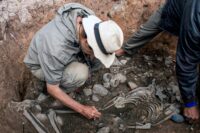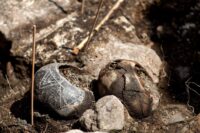 Archaeologists have unearthed what they believe is an elite priestly tomb at the Pacopampa archaeological site in the Cajamarca region of northern Peru. It dates to the Pacopampa I phase, ca. 1200-1,000 B.C.
Archaeologists have unearthed what they believe is an elite priestly tomb at the Pacopampa archaeological site in the Cajamarca region of northern Peru. It dates to the Pacopampa I phase, ca. 1200-1,000 B.C.
The tomb consists of a large circular pit ten feet in diameter and 3.3 feet deep. The body was placed at the bottom of the pit, his legs partially flexed, with small spherical ceramic bowls incised with geometric designs, a carved bone spatula and other offerings, including a seal in the shape of a hand. He was then buried under six layers of black soil mixed with ash.
 Two more seals were found in the upper strata along the edges of the tomb. One features an anthropomorphic face design facing east; the other a jaguar facing west. Archaeologists hypothesize that the seals were actually paint stamps, used for the body painting exclusive to the Pacopampa elite.
Two more seals were found in the upper strata along the edges of the tomb. One features an anthropomorphic face design facing east; the other a jaguar facing west. Archaeologists hypothesize that the seals were actually paint stamps, used for the body painting exclusive to the Pacopampa elite.
“He is one of the first priests in the Andes to have a series of offerings,” [archaeologist Juan Pablo Villanueva] said, adding that “the funerary context is intact.” […]
“The find is extremely important because he is one of the first priests to begin to control the temples in the country’s northern Andes,” Japanese archaeologist Yuji Seki, who has been working at the site for 18 years, told AFP. […]
Seki said the find helped demonstrate that even that long ago, “powerful leaders had appeared in the Andes.”
